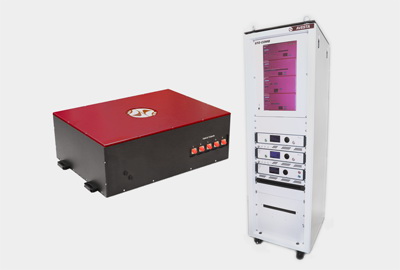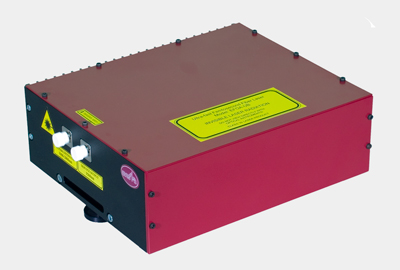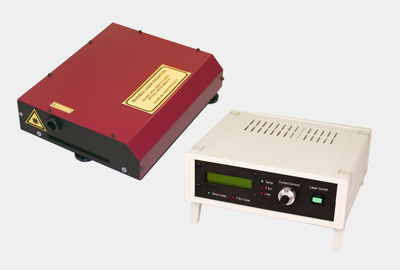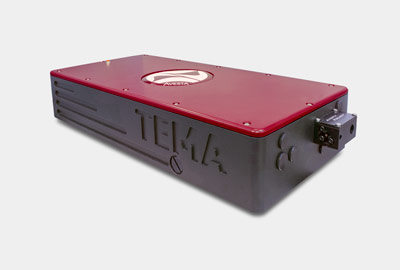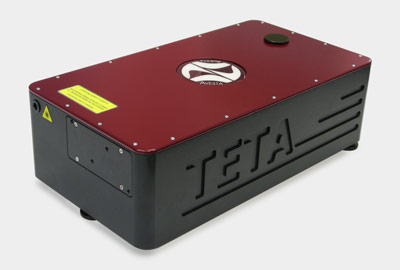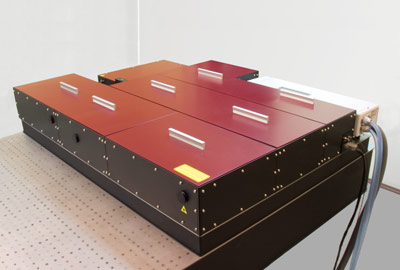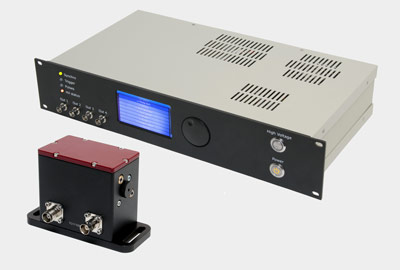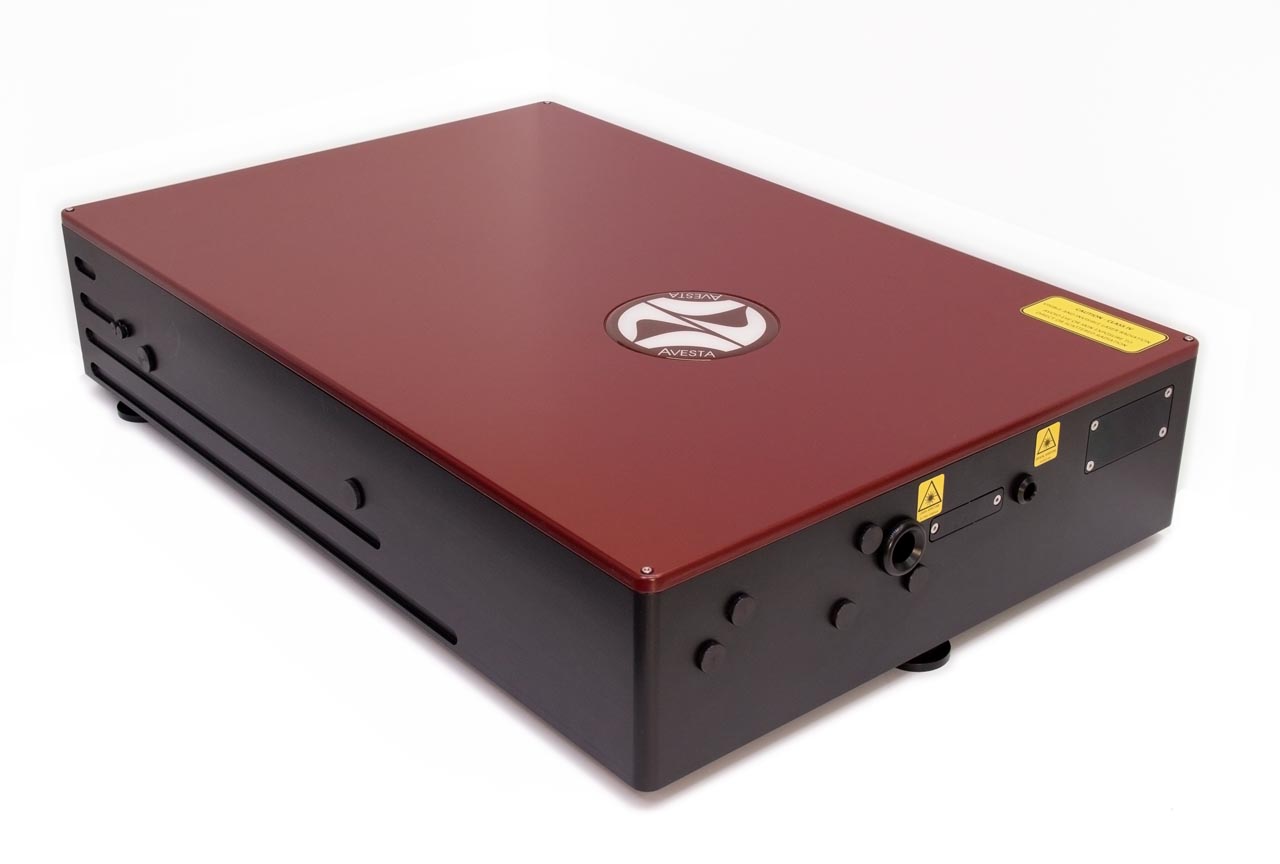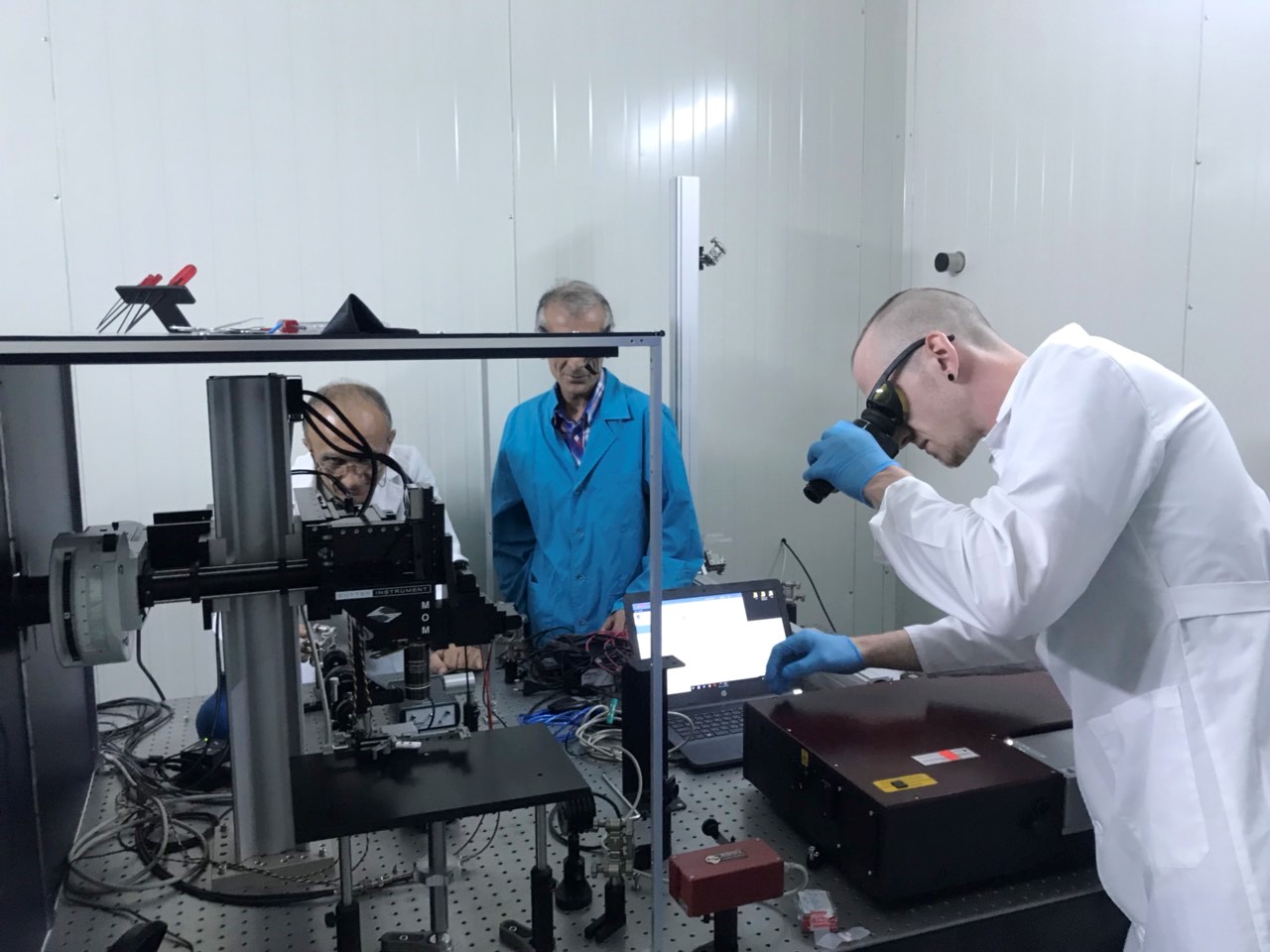- Oscillators
- Femtosecond Amplifiers
- Diagnostics
- Components
- Optomechanics
Articles
This section is still under construction. In this section you may find selected articles with experimental results having been obtained with the use of our equipment.
Oscillators
- Ti:sapphire laser synchronised with femtosecond Yb pump laser via nonlinear pulse coupling in Ti:sapphire active medium
- Femtosecond Er3+ fiber laser for application in an optical clock
- Efficient source of femtosecond pulses and its use for broadband supercontinuum generation
- Self-mode-locking in erbium-doped fibre lasers with saturable polymer film absorbers containing single-wall carbon nanotubes synthesised by the arc discharge method
- Fabrication of superconducting nanowire single-photon detectors by nonlinear femtosecond optical lithography
- Highly effective 525 nm femtosecond laser crosslinking of collagen and strengthening of a human donor cornea
N.V. Didenko, A. V. Konyashchenko, D. A. Konyashchenko, P. V. Kostryukov, I. I. Kuritsyn, A. P. Lutsenko, A. O. Mavritskiy
A laser system utilising the method of synchronous pumping of a Ti : sapphire laser by a high-power femtosecond Yb3+-doped laser is described. The pulse repetition rate of the Ti : sapphire laser is successfully locked to the repetition rate of the Yb laser for more than 6 hours without the use of any additional electronics. The measured timing jitter is shown to be less than 1 fs. A simple qualitative model addressing the synchronisation mechanism utilising the cross-phase modulation of oscillation and pump pulses within a Ti : sapphire active medium is proposed. Output parameters of the Ti : sapphire laser as functions of its cavity length are discussed in terms of this model. A laser system utilising the method of synchronous pumping of a Ti : sapphire laser by a high-power femtosecond Yb3+-doped laser is described. The pulse repetition rate of the Ti : sapphire laser is successfully locked to the repetition rate of the Yb laser for more than 6 hours without the use of any additional electronics. The measured timing jitter is shown to be less than 1 fs. A simple qualitative model addressing the synchronisation mechanism utilising the cross-phase modulation of oscillation and pump pulses within a Ti : sapphire active medium is proposed. Output parameters of the Ti : sapphire laser as functions of its cavity length are discussed in terms of this model.
Keywords: synchronous pumping, femtosecond pumping, Ti:sapphire laser, cross-phase modulation.
| Spectral range | 520-2200 nm |
| Comb spacing (Frep) | 125 MHz |
| Tuning range of offset frequency Fceo | >100 MHz |
| Stability | 5*10^-13 in 1 s |
M. A. Gubin, A. N. Kireev, A. V. Tausenev, A. V. Konyashchenko, P. G. Kryukov, D. A. Tyurikov, A. S. Shelkovikov The main elements needed for the realization of a compact femtosecond methane optical clock are developed and studied. A femtosecond laser system on an Er3+ fiber (λ = 1.55 μm) contains an oscillator, an amplifier, and a fiber with a relatively high nonlinearity in which the supercontinuum radiation is generated in the range 1–2 μm. In the supercontinuum spectrum, the fragments separated by an interval that is close to the methane-optical reference frequency (λ = 3.39 μm) exhibit an increase in intensity. The supercontinuum radiation is converted into the difference frequency in a nonlinear crystal to the range of the methane-reference frequency (λ = 3.3–3.5 μm), so that the frequency components of the transformed spectrum have sufficient intensities for the subsequent frequency-phase stabilization with respect to the methane reference. A system that stabilizes the pulse repetition rate of the femtosecond Er3+laser is also employed. Thus, the repetition rate of the ultrashort pulses of the femtosecond fiber laser is locked to the methane reference. The pulse repetition rate is compared with the standard second. Thus, the scheme of an optical clock is realized.
| Spectral coverage | 1100-2000 nm |
| Average output power | >150 mW |
| Repetition rate | 50...70 MHz |
Anton V. Tausenev, P. G. Kryukov, M. M. Bubnov, M. E. Likhachev, E. Yu. Romanova, M. V. Yashkov, V. F. Khopin and M. Yu. Salganskii A femtosecond Er3+-doped fibre laser system is developed and studied. The system contains a master oscillator operating in the pulse stretching regime, an amplifier of chirped pulses, and a device for pulse compression. The laser emits 1.55-μm, 100-fs, 90-mW pulses with a pulse repetition rate of 25 MHz. The setup was used for supercontinuum generation in an optical fibre heavily doped with GeO2. The width of the generated supercontinuum was close to an octave.
| Wavelength | 1560±10 nm |
| Pulse duration | 50 fs to 5 ps |
| Average power | 10 mW to 5 W |
| Repetition rate | 65...100 MHz (fixed) |
Anton V. Tausenev, Elena D. Obraztsova, A. S. Lobach, A. I. Chernov, Vitalii I. Konov, Aleksandr V. Konyashchenko, P. G. Kryukov and Evgenii M Dianov We studied the ring and linear schemes of erbium-doped fibre lasers in which passive mode locking was achieved with the help of saturable absorbers made of high-optical quality films based on cellulose derivatives with dispersed single-wall carbon nanotubes. The films were prepared by the original method with the use of nanotubes synthesised by the arc discharge method. The films exhibit nonlinear absorption at a wavelength of 1.5 μm. Pulses in the form of optical solitons of duration 1.17 ps at a avelength of 1.56 μm were generated in the ring scheme of the erbium laser. The average output power was 1.1 mW at a pulse repetition rate of 20.5 MHz upon pumping by the 980-nm, 25-mW radiation from a laser diode. The pulse duration in the linear scheme was reduced to 466 fs for the output power up to 4 mW and a pulse repetition rate of 28.5 MHz. The specific feature of these lasers is a low pump threshold in the regime of generation of ultrashort pulses.
| Wavelength | 1050 nm |
| Pulse duration | 70...150 fs |
| Average power | up to 12 W |
| Repetition rate | 80 MHz |
N. V. Minaev, M. A. Tarkhov, D. S. Dudova, P. S. Timashev, B. N. Chichkov and V. N. Bagratashvili This paper describes a new approach to the fabrication of superconducting nanowire single-photon detectors from ultrathin NbN films on SiO2 substrates. The technology is based on nonlinear femtosecond optical lithography and includes direct formation of the sensitive element of the detector (the meander) through femtosecond laser exposure of the polymethyl methacrylate resist at a wavelength of 525 nm and subsequent removal of NbN using plasma-chemical etching. The nonlinear femtosecond optical lithography method allows the formation of planar structures with a spatial resolution of ~50 nm. These structures were used to fabricate single-photon superconducting detectors with quantum efficiency no worse than 8% at a wavelength of 1310 nm and dark count rate of 10 s−1 at liquid helium temperature. Keywords: optical lithography, nanostructures, single-photon detector, femtosecond lithography
| Wavelength | 1050 nm |
| Pulse duration | 70...150 fs |
| Average power | up to 12 W |
| Repetition rate | 80 MHz |
B.S. Shavkuta, M.Y. Gerasimov, N.V. Minaev, D.S. Kuznetsova, V.V. Dudenkova, I.A. Mushkova, B.E. Malyugin, S.L. Kotova, P.S. Timashev, S.V. Kostenev
Amplifiers
- An atom probe tomography prototype with laser evaporation
- Multiterawatt Hybrid (Solid/Gas) Femtosecond Systems in the Visible (Chapter 6 from High Energy and Short Pulse Lasers)
- Femtosecond Laser Simulation Facility for SEE IC Testing
| Average power | up to 20 W |
| Central wavelength | 1030 nm |
| Pulse energy | up to 2 mJ |
| Repetition rate | up to 1 MHz |
| Pulse duration | <270 fs |
S.V. Rogozhkin, A.A. Aleev, A.A. Lukyanchuk, A.S. Shutov, O.A. Raznitsyn, S.E. Kirillov The results of development, creation, and tests of an atom-probe prototype with femtosecond laser evaporation and a position-sensitive microchannel detector with delay lines for the tomographic (3D) analysis of chemical composition of materials are presented. The atom-probe tomography is based on the principle of atom-by-atom “disassembling” of materials and projection magnification, which was previously used in field-ion microscopy, as well as the time-of-flight mass spectrometry that is applied to each evaporated ion. The prototype characteristics (mass resolution, spatial resolution, and data-collection efficiency) were demonstrated in study of tungsten.
| Central wavelength | 800±20 nm (fixed) |
| Pulse energy | from 50 uJ to 40 mJ |
| Pulse repetition rate | up to 10 kHz |
| Pulse duration | from 30 to 120 fs |
Leonid D. Mikheev and Valery F. Losev (2016). Multiterawatt Hybrid (Solid/Gas) Femtosecond Systems in the Visible, High Energy and Short Pulse Lasers, Dr. Richard Viskup (Ed.), InTech, DOI: 10.5772/63972. A novel hybrid (solid/gas) approach to the development of femtosecond high‐intensity laser systems operating in the visible is presented in this chapter. Behind this approach is a combination of a solid‐state front end relying on widespread and highly developed techniques for femtosecond pulse generation in the near infrared with a photochemically driven boosting amplifier operating in the visible spectral range. Historical background of developing photochemically pumped gas lasers on broad bandwidth electronic transitions in molecules and physical principles of their operation are briefly summarized as well. The architecture and the design issues of the hybrid femtosecond systems relying on the amplification of the second harmonic of Ti:sapphire front ends in the photodissociation XeF(C‐A) power‐boosting amplifiers driven by the VUV radiation from electron‐beam‐to‐VUV‐flash converters are described, as well as breakthrough results of proof‐of‐principle experiments demonstrating a high potential of the hybrid approach. Wavelength scaling of laser‐matter interaction is shortly discussed to demonstrate advantages of shorter driver wavelengths for some applications with main emphasis placed on recombination‐pumped soft X‐ray lasers.
| Central wavelength | 800±20 nm (fixed) |
| Pulse energy | from 50 uJ to 40 mJ |
| Pulse repetition rate | up to 10 kHz |
| Pulse duration | from 30 to 120 fs |
A. N. Egorov et al., "Femtosecond Laser Simulation Facility for SEE IC Testing," 2014 IEEE Radiation Effects Data Workshop (REDW), Paris, 2014, pp. 1-4. doi: 10.1109/REDW.2014.7004570 The new SEE laser simulation facility based on femtosecond laser source with tunable pulse duration is presented, and its most important features are discussed. The influence of laser pulse duration on simulation results is observed.
Diagnostics
- Contrast degradation in a chirped-pulse amplifier due to generation of prepulses by postpulses
| Possible input wavelength range | 700-1500 nm |
| Scan range | up to 4 ns |
| Dynamic range | 10^10 |
| Sensitivity | 50-100 uJ |
N.V. Didenko, A.V. Konyashchenko, A.P. Lutsenko, and S.Yu. Tenyakov Experiment and modeling show that the refractive index nonlinearity can significantly degrade the contrast of a chirped-pulse amplifier seeded with a pulse and a single postpulse. Multiple powerful non-equidistant pre- and postpulses are generated. For a Gaussian pulse and a hat-top beam, an incident postpulse of energy W results in a prepulse of energy 0.58B^2 W, where B is the nonlinear phase (B-integral) of the main pulse. Calculations show that level of satellites due to gain saturation is negligibly small. Experimental results for Ti:Sapphire regenerative and multipass amplifiers and prepulse generation in fused silica agree well with the theory.
Components
- Efficient amplification of a femtosecond Ti:sapphire laser with a ring regenerative amplifier
| Possible operating wavelength range | 200...2700 nm |
| Max. output rep. rate | up to 1 MHz |
| Rise time | down to 700 ps |
| Clear aperture | up to 20 mm |
| Contrast ratio | >1500:1 |
Wei Zhang, Hao Teng, Zhaohua Wang, Zhongwei Shen, and Zhiyi Wei, Appl. Opt. 52, 1517-1522 (2013). A high-stability and high-efficiency ring Ti:sapphire regenerative amplifier is demonstrated based on a double-gating pulse picker at a repetition rate of 1 kHz. Pulse energy up to 5.7 mJ is obtained using a pump energy of 20.0 mJ at 527 nm, corresponding to a relatively high slope efficiency of 30.3%. After a grating compressor, the laser pulse is compressed to 37.2 fs with an energy of 4.1 mJ. The beam quality factors M2 are 1.4 and 1.3 in tangential and sagittal directions, respectively. The measured root mean square energy stability is better than 0.31% over an 11 h period.
Latest News
Ti:S oscillator with up to 3 W output power at 100 fs
We have ramped up the maximum available output power for the TiF-100 series to more than 3 Watts at 800 nm, 100 fs, 80 MHz. The tuning range has also been extended to 720-950 nm, while an optional modification that covers 850-1040 nm is also available. The system features a high-power low-noise integrated DPSS laser […]
TiF-100ST-F6 femtosecond Ti:S oscillator with Frep locking for multiphoton microscopy at CANDLE, Armenia
The TiF-100ST-F6 femtosecond Ti:S oscillator with a built-in pump laser, also equipped with the ALock PLL electronics unit for pulse repetition rate locking to an external RF source has been installed at the Synchrotron Research Institute’s CANDLE facility in Armenia. The setup has been developed and commercialized during the joint Russia-Armenia project supported by FASIE (Innovation […]




